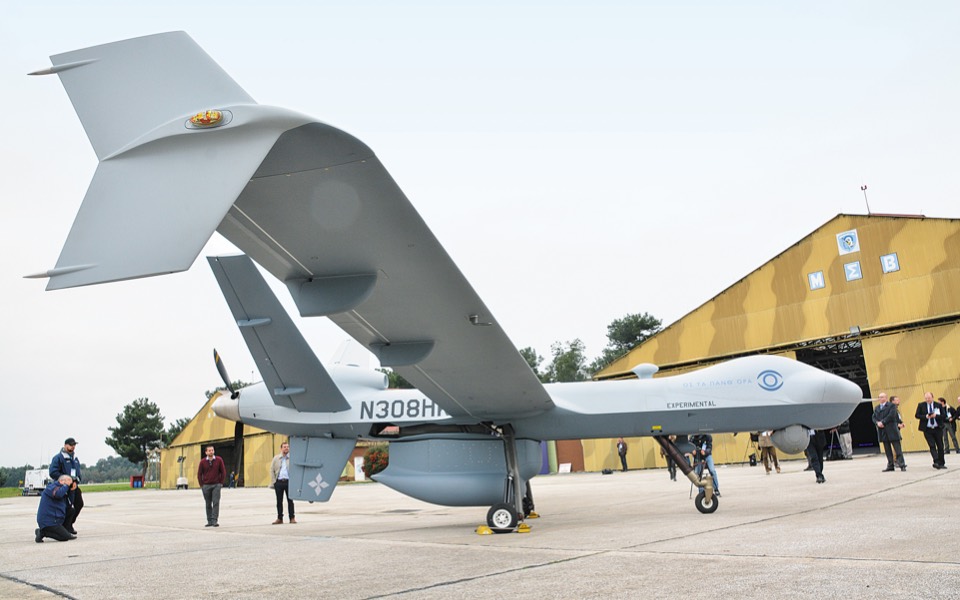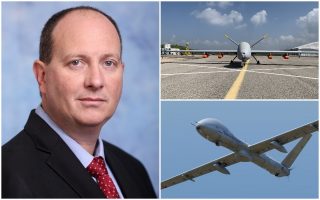How drones are changing modern warfare
Outlining UAVs’ significant capabilities, retired USAF lieutenant general says Greece should invest in new defense technology

Unmanned aerial vehicles are significantly changing the contemporary battlefield by offering a huge comparative advantage to the armed forces that own them, says United States Air Force Lieutenant General (retired) Dave Deptula, dean of the Mitchell Institute for Aerospace Studies, in an interview with Kathimerini.
He says that although China has invested huge sums in developing its armed forces, both technologically and structurally, including UAVs, the US holds the most advanced technology in this area. However, he adds, Washington should be willing to share its technology and UAV capabilities with its allies, who for their part should take advantage of this opportunity and push the US to become more open so that a broad alliance can ensure peace and stability on the planet.
 How are UAVs changing the modern battlefield?
How are UAVs changing the modern battlefield?
Drones, unmanned aerial vehicles, or remotely piloted aircraft, whatever you want to call them, their impact will be much greater than anyone can imagine today. Now, not necessarily as a primary means of force application, but in enhancing the capabilities of military and intelligence operations. There’s a company out there that used to run a commercial that said essentially this: “We don’t make the things you use, we make the things you use better.” I think that will apply to the impact of UAVs in the future. Now the reason is because I think it’s important to understand the advantages of UAVs relative to manned vehicles that optimize their application.
Essentially, there are six points I want to highlight. The first one is persistence: the UAVs allow the time to observe, to evaluate and then act very quickly or take all the time necessary to be sure of a particular action.
The second important characteristic is their relative invulnerability. UAVs today allow us to project power without projecting vulnerability, or at least the same degree of vulnerability as you need to within an inhabited system. Third, precision. When you think about it, UAVs today are the most precise means of employing force in a way that reduces collateral damage and minimizes casualties.
Fourth, oversight: UAVs allow for more ethical oversight than any other means of force application.
Fifth, utility in economy: UAVs have the potential to amplify the effectiveness of very highly capable aircraft by supplementing their sensor and shooter capabilities. So, if you look to the future, they’ll be able to act as weapons mules or a robotic wingman, if you will, or carriers that will have extra weapons for advanced aircraft regardless of the type and they’ll be able to do that at a fraction of the cost.
And finally, there’s an old saying that quantity has a quality all of its own, because UAVs are lower-cost relative to inhabited aircraft. They can be bought in much larger numbers that give rise to new concepts of operation, such as swarming or overwhelming enemy defenses.
So, the summary of those unique characteristics is that UAVs provide their users with an asymmetric advantage relative to opponents that do not possess them.
Will we reach a point where most air and naval assets will be unmanned?
The answer to that question has yet to be determined. But I think that there are people out there that are leaping to a conclusion that it’s not necessary to go to. I don’t know if we’ll get to the point where most air and naval assets will be unmanned. But I will tell you, if that does happen, it’s not going to be in the very near future. Like I said, up front, I think uninhabited aircraft are going to become more and more applicable. But it doesn’t mean that we’re going to take humans out of the equation… You know, think about it, commercial aircraft today can take off, fly to a location and land without any pilot input whatsoever. But say you turn left when you walk into the plane and look into the cockpit, and there’s nobody there, it’s empty, you see a box on the floor, and that’s it. Are you going to be willing to fly the airplane? I think most people would say no. So it’s not a matter of, you know, capability. There’s also a psychological piece, too. But I don’t think it’s going to happen anytime soon. It might in the future.
According to some reports, the use of Turkish UAVs in Syria and Azerbaijan was path-breaking. What is your assessment of this?
Well, I think that they did use the UAVs to their advantage in both those locations. And I don’t know about path-breaking, but certainly it had a positive impact and allowed them to achieve what I talked about earlier – it capitalized on those capabilities to achieve an asymmetric advantage over their adversaries. And they used them very wisely because they had large numbers. If they lost a couple, it was no big deal. They were able to use precise application of force and lead directly to their objective. So, I think that, in some respects, it was path-breaking.
How can a country like Greece defend itself against this new threat?
Well, first, Greece ought to take advantage of all the attributes that I spoke about earlier in acquiring their own and supplementing their own air force with the UAVs for defensive purposes, and secondarily in considering the threats that may be posed. There they should also explore techniques. They can defend their air bases in operating locations from UAVs. And there are plenty of them out there, whether they are electromagnetic counteroperations or countermeasures, or directed energy, or kinetic means, there are ways to defend against remotely piloted aircraft, I mean. Part of it is detection. You need to be able to find the threat, you need to be able to then produce a response that can take it down. And the Greek defense department needs to take a look at that, and invest in optimal ways to ensure that they both have an offensive capability, as well as a defensive capability.
China is also a leader in UAV design and production. Is that a threat to US interests?
China’s investing enormous amounts of their government resources into military growth, both technologically as well as capacity-wise. And UAV design and production is one of the areas that they’ve invested a lot in. Frankly, they are very savvy in providing those capabilities to countries around the world where the United States has not allowed for or provided those countries access to US design and many of us have been working for years to try to change that. But I would also tell you that the Chinese systems have not been in the past up to par or as capable as US designs, but they’re certainly advancing to a point that they will be in the not-too-distant future.
Has the US lost its edge in this competition?
For the time being, the US has not lost its edge. As a matter of fact the US is out in front. What we need is more allies and partners to work with the US. It’s a mutual issue. But the US has to be willing to share its technologies and capabilities with our friends and partners. And our friends and partners need to take advantage of that and pressure the United States to operate these systems so that we’ll all be working together to achieve peace and stability in areas around the world.
From the defense side, have effective anti-UAV systems been developed?
Yes, yes they have. I really don’t want to get into details, because anytime you get into details in a public forum, the Chinese take advantage of that. But the bottom-line answer is yes.
Finally, what are the geopolitical consequences of the spread of UAV use?
I’m a strong believer in the fact that remotely piloted aircraft are really advancing the transition to a much more autonomous ability to assist airmen in the accomplishment of their mission tasks across the entire spectrum of aerospace operations. I think in the future you’re going to see UAVs increasingly becoming more and more autonomous. At the same time, there’s going to be a human in the loop controlling the effects of these autonomous aircraft. What these things are really going to be are coordinated autonomously piloted aircraft. You know, distinguish the use of aircraft flying autonomously, versus those that are actually remotely piloted. The US is actively working to develop what are called “loyal wingman UAVs.” I think you’re going to see more manned-unmanned teaming. A human pilot can give general inputs and guidance to the UAVs and be confident that, relying on advanced computation and artificial intelligence, that the UAVs will behave as they’re required. You’re going to see more and more emerging artificial intelligence-enabled UAVs that can fulfill an ever expanding range of missions that are normally accomplished by manned aircraft.





